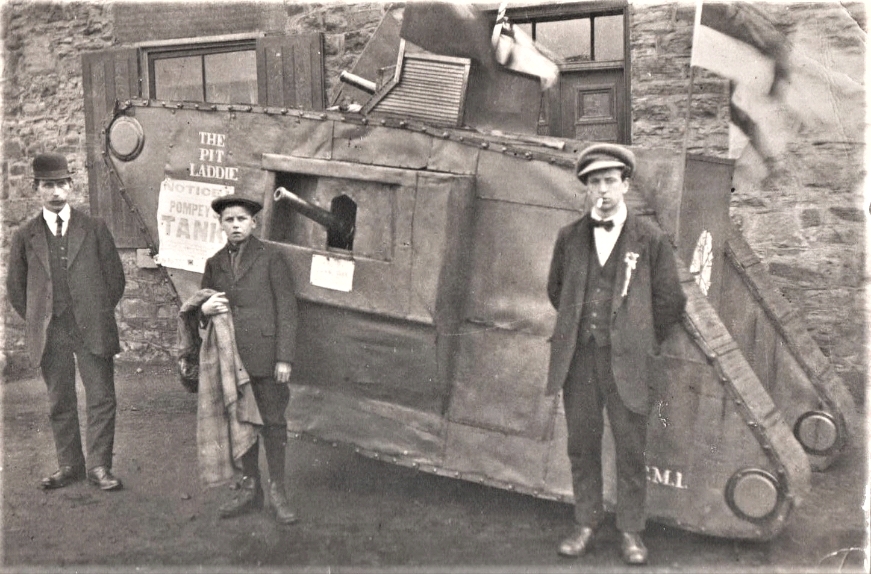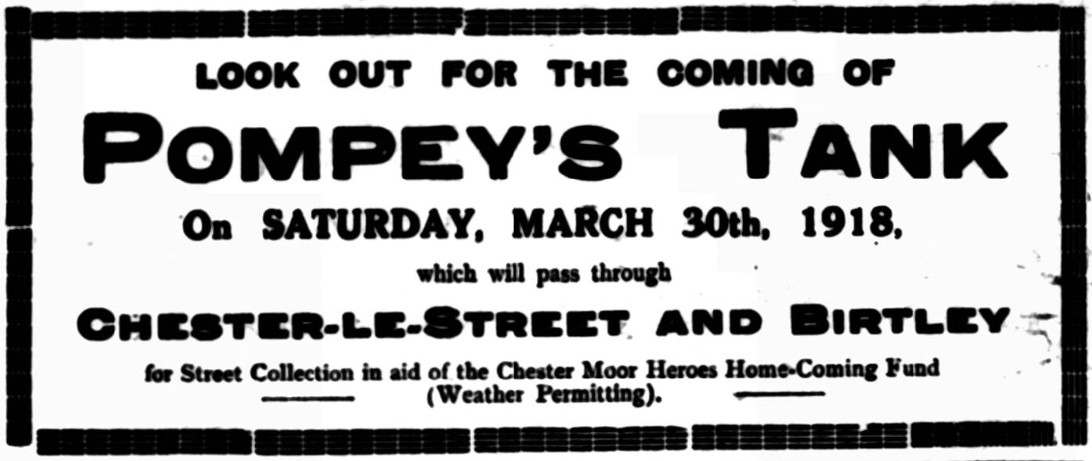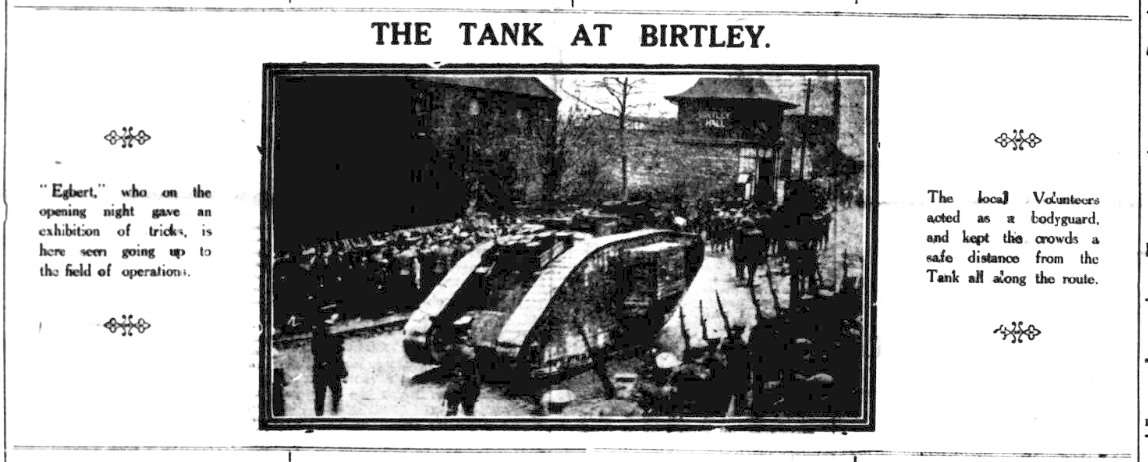Pompey's Tank

At the March 2023 meeting of Washington History Society the attached postcard photograph was produced by one of our members, who was unable to provide any information on its origin. The postcard was addressed to Frank Robson, 9 Nelson Street, Washington. It appears not to have been posted as it does not have a stamp nor is it franked.
From the dress of the figures in the photograph, and the design of the mock tank, members agreed that it dated from the First World War. Though it's name was The Pit Laddie, the poster on its side called it a Pompey Tank. An 1896 dialect dictionary of words and phrases from the Hetton le Hole area lists "Pompey" as meaning a small boy or dwarf, perhaps referring to the small size of the model. Enquiries with the Portsmouth History Society, and Bovington Tank Museum did not find any links with that area.
However one of our members, Peter Welsh, who has recorded every WW1 Washington casualty, recalled that he had referred to the "Pompey's Tank" in his excellent book, Washington in the Great War ‘Whisht Lads’. Below is an edited extract from the book:
“At what point the village (Fatfield) considered erecting a memorial to the men who had died in the war isn't clear, although there had been a Welcome Home Committee since at least October 1914, Miss Reeman of the Vicarage being the leading light. They had no doubt assisted, insofar as they could, the bereaved and the relatives of those men who were away. Concerts and sales of work had been held in order to provide comforts for the troops and to raise money for the presentation of watches. There are no minutes telling us when they proposed a monument, but in late August 1918 it was becoming apparent that the German army had effectively shot its bolt in the attacks of spring and early summer 1918, and that the fighting qualities of the British, French and increasing numbers of Americans were starting to prevail. There had been presentations of watches to those who had been awarded decorations and it was a natural step to move from that idea to the idea of a War Memorial.”
In May 1918 The Chester Le Street Chronicle reported a fund raising football match:
"On Saturday a comic football match was played on the Fatfield Football ground between the Welcome Home Fund Committees of Fatfield and Pelaw Grange and Brown's Buildings. In the morning a procession was formed composed of many comic characters. These met at the Wheatsheaf Inn, Pelaw Grange and, headed by a mixed band they proceeded to the Barley Mow and back to Brown's Buildings. From there they journeyed to Portobello, Harraton Colliery and on to Fatfield. They were accompanied by Pompey's Tank (kindly lent by the Chester Moor Welcome Home Fund.) Mr T Watson, 47 Lambton Terrace, Chester Le Street, who made this fine model, has been successful up to the present in raising over £50 by exhibiting it in aid of war charities. On this occasion the collection made by the tank was devoted to the Brown's Buildings and Pelaw Grange Fund and the proceeds of the football match were given to the Fatfield Fund. Collections were taken by representatives and Red Cross nurses and various other characters along the route and also on the football field. There was a large gathering present to watch the comic match, the referee being represented as a police constable who vigorously swung a drum stick and blew his whistle to the diversion of the comic players, who themselves created much mirth by their eccentricities. They were represented by the following characters; Soldiers/sailors, admiral, curate, pierrot, pierrettes, Highlander, Principal Boy, Jew, Janissary, Hussar, coster, Spanish toreador, Colleen Bawn etc etc. The kick off was made by Mr John Todd of the Ferry Boat Inn. The following were the teams-
Fatfield- Goal-Scott, T Clark, T Southern, W Scott, B Scott, A Scott, V Gowland, G Suddick, G Elliott, R Mossman and J Rodham.
Brown's Buildings- Goal -T Talbot, J Gasgoygne, W Younger, J Green, E Green, R Corvie, P Dalton, A Sougat, G Dalton, W Clark, and G Robson.
Referee -V Simpson.
The game was abandoned owing to rain."
How entirely English, a great day spoiled at the end by the weather!
Further cuttings and census records reveal that the model tank had been made by 26 year old colliery hewer, Thomas Watson, and had appeared in fund raising events between March and May 1918 for the Chester Moor Welcome Home Fund (might that be Thomas in the right of the photograph?).


Every town and village in the country took the initiative to raise monies for the war effort and local relief, with parades and demonstrations and floats, including model tanks- a weapon that had only appeared in battle 18 months before. ‘Pompey’s Tank’ might have referred to a real tank adopted by the Birtley committee, but no such reference can be found.
It could be that Frank Robson bought the postcard at one of these events for himself, never intending to post it.
In the first week of April 1918 a real, battle-scarred tank, Egbert, appeared at the ‘Birtley Tank Week’, a war bond promotion. Such events continued even after hostilities ceased in November 1918, but the Pit Laddie is not mentioned in further records, and the eventual fate of the model is not known.
